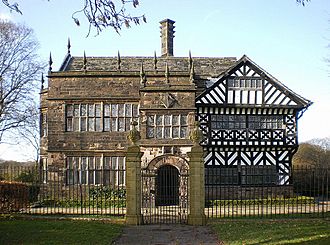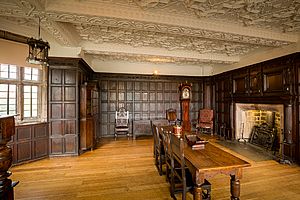Hall i' th' Wood facts for kids
Quick facts for kids Hall i' th' Wood |
|
|---|---|

A front view of the Hall i' th' Wood manor house.
|
|
| General information | |
| Architectural style | Medieval |
| Town or city | Bolton, Greater Manchester |
| Country | England |
| Coordinates | 53°36′02″N 2°25′08″W / 53.60049°N 2.41895°W |
| Completed | 16th century |
| Designations | |
|
Listed Building – Grade I
|
|
| Official name: Hall i' th' Wood | |
| Designated: | 22 April 1952 |
| Reference #: | 1388052 |
Hall i' th' Wood is a historic manor house in Bolton, England, that was first built in the 1500s. It is a Grade I listed building, which means it is considered a very important building for the nation's history. Today, it is a museum run by the local government.
The name "Hall i' th' Wood" is how you would say "Hall in the Wood" in the old local dialect of Northern England. It is pronounced Awl-ith-wood.
The house is famous because the inventor Samuel Crompton lived here. In the 1700s, he created the spinning mule, a machine that changed the way cloth was made, right inside this house.
Contents
History of the Hall
The oldest part of Hall i' th' Wood was built in the 16th century. It has a classic look with a timber frame and a roof made of large, flat stones called flags. More parts were added to the house later on. A stone section was built in 1591, and another in 1648.
A House of Many Homes
Unlike many manor houses where one wealthy family lived, Hall i' th' Wood was different. It was divided into four or five separate homes. Each home had its own front door and staircase. Families who worked in local industries lived in these homes.
Samuel Crompton's Amazing Invention
In the 18th century, one of the people living in the hall was an inventor named Samuel Crompton. It was here that he designed and built his famous machine, the spinning mule.
Around 1779, Crompton's machine was ready. It could spin cotton thread that was strong and fine enough to make a soft fabric called muslin. This was a huge breakthrough for the textile industry. His invention became known as the "muslin wheel" or the "Hall i' th' Wood wheel" because of where it was created.
From Home to Museum
In 1899, a wealthy businessman named William Lever (who later became Lord Leverhulme) bought Hall i' th' Wood. He hired experts to carefully restore the old building and bring it back to its former glory.
A year later, in 1900, Lord Leverhulme gave the house to the town of Bolton as a gift. It was then turned into a museum so that everyone could visit and learn about its amazing history.
The Hall in Recent Times
The hall's fascinating history has made it a point of interest for more than just museum visitors.
In 2008, an episode of the TV show Most Haunted was filmed at the hall to investigate stories of ghosts. The building was also the subject of a poem by Letitia Elizabeth Landon in 1833, which described the many changes the hall had seen over the centuries.
Closing for Repairs
In 2021, the hall had to close its doors to the public. The old building had serious structural problems, including rotting wood, dampness, and damage from vandals.
In December 2024, it was announced that the organization Historic England had promised £47,500 to help pay for important survey work. This work will help experts understand the damage and make a plan to repair and save this historic building.
See also
- Grade I listed buildings in Greater Manchester
- Listed buildings in Bolton
- Hall i' th' Wood railway station


